Woolworths: Macro-Environment and Industry Analysis
VerifiedAdded on 2022/10/10
|10
|2033
|72
AI Summary
This report outlines Woolworths, a Sydney Based, Australia grocery retailer and its competitive stand in the Australian supermarket industry. The study of the external and industry environment influencing the Australian retail and Woolworths is undertaken and centered on the study, it has been identified that how it is influencing the performance of Woolworths.
Contribute Materials
Your contribution can guide someone’s learning journey. Share your
documents today.
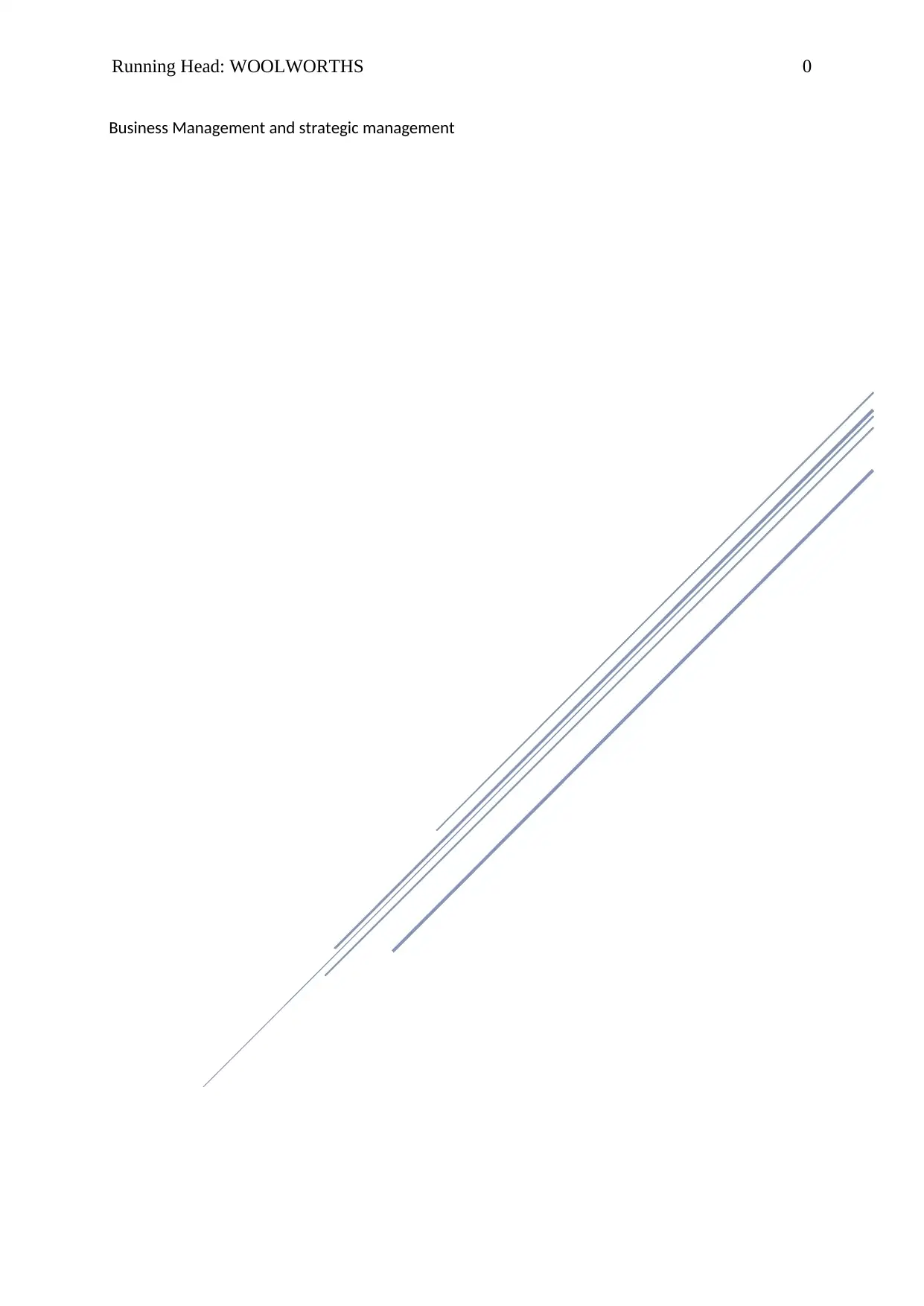
Running Head: WOOLWORTHS 0
Business Management and strategic management
Business Management and strategic management
Secure Best Marks with AI Grader
Need help grading? Try our AI Grader for instant feedback on your assignments.
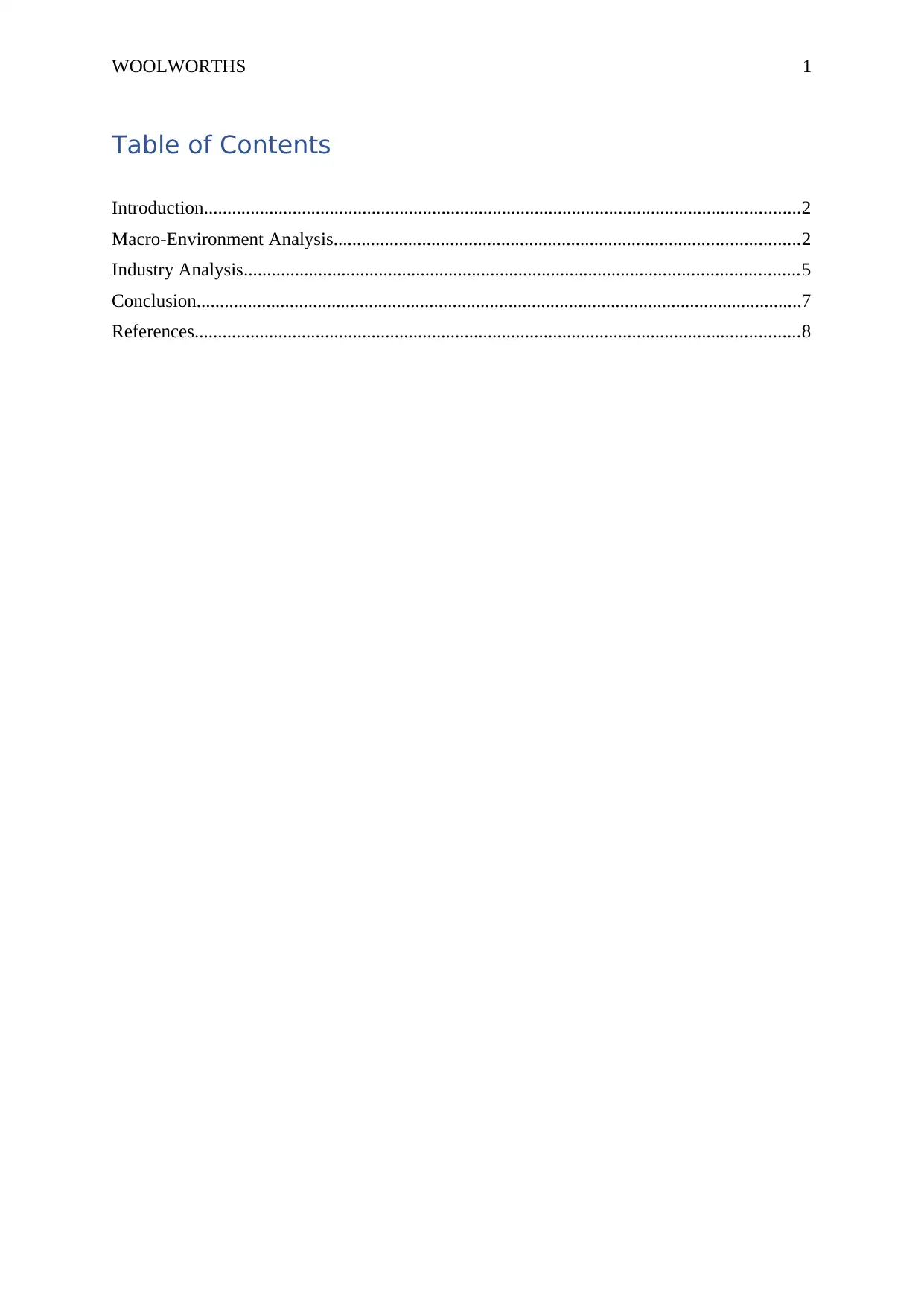
WOOLWORTHS 1
Table of Contents
Introduction................................................................................................................................2
Macro-Environment Analysis....................................................................................................2
Industry Analysis.......................................................................................................................5
Conclusion..................................................................................................................................7
References..................................................................................................................................8
Table of Contents
Introduction................................................................................................................................2
Macro-Environment Analysis....................................................................................................2
Industry Analysis.......................................................................................................................5
Conclusion..................................................................................................................................7
References..................................................................................................................................8
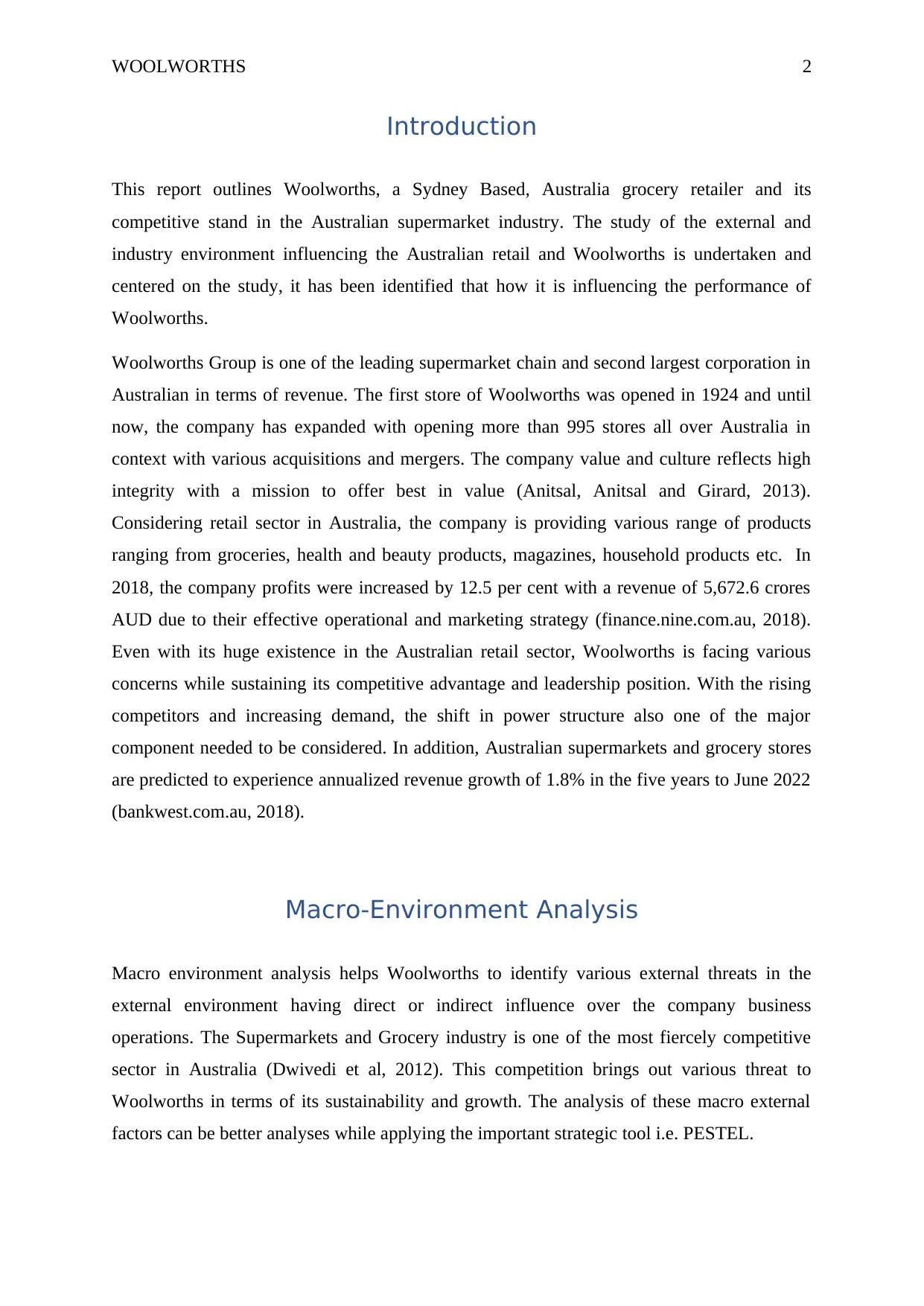
WOOLWORTHS 2
Introduction
This report outlines Woolworths, a Sydney Based, Australia grocery retailer and its
competitive stand in the Australian supermarket industry. The study of the external and
industry environment influencing the Australian retail and Woolworths is undertaken and
centered on the study, it has been identified that how it is influencing the performance of
Woolworths.
Woolworths Group is one of the leading supermarket chain and second largest corporation in
Australian in terms of revenue. The first store of Woolworths was opened in 1924 and until
now, the company has expanded with opening more than 995 stores all over Australia in
context with various acquisitions and mergers. The company value and culture reflects high
integrity with a mission to offer best in value (Anitsal, Anitsal and Girard, 2013).
Considering retail sector in Australia, the company is providing various range of products
ranging from groceries, health and beauty products, magazines, household products etc. In
2018, the company profits were increased by 12.5 per cent with a revenue of 5,672.6 crores
AUD due to their effective operational and marketing strategy (finance.nine.com.au, 2018).
Even with its huge existence in the Australian retail sector, Woolworths is facing various
concerns while sustaining its competitive advantage and leadership position. With the rising
competitors and increasing demand, the shift in power structure also one of the major
component needed to be considered. In addition, Australian supermarkets and grocery stores
are predicted to experience annualized revenue growth of 1.8% in the five years to June 2022
(bankwest.com.au, 2018).
Macro-Environment Analysis
Macro environment analysis helps Woolworths to identify various external threats in the
external environment having direct or indirect influence over the company business
operations. The Supermarkets and Grocery industry is one of the most fiercely competitive
sector in Australia (Dwivedi et al, 2012). This competition brings out various threat to
Woolworths in terms of its sustainability and growth. The analysis of these macro external
factors can be better analyses while applying the important strategic tool i.e. PESTEL.
Introduction
This report outlines Woolworths, a Sydney Based, Australia grocery retailer and its
competitive stand in the Australian supermarket industry. The study of the external and
industry environment influencing the Australian retail and Woolworths is undertaken and
centered on the study, it has been identified that how it is influencing the performance of
Woolworths.
Woolworths Group is one of the leading supermarket chain and second largest corporation in
Australian in terms of revenue. The first store of Woolworths was opened in 1924 and until
now, the company has expanded with opening more than 995 stores all over Australia in
context with various acquisitions and mergers. The company value and culture reflects high
integrity with a mission to offer best in value (Anitsal, Anitsal and Girard, 2013).
Considering retail sector in Australia, the company is providing various range of products
ranging from groceries, health and beauty products, magazines, household products etc. In
2018, the company profits were increased by 12.5 per cent with a revenue of 5,672.6 crores
AUD due to their effective operational and marketing strategy (finance.nine.com.au, 2018).
Even with its huge existence in the Australian retail sector, Woolworths is facing various
concerns while sustaining its competitive advantage and leadership position. With the rising
competitors and increasing demand, the shift in power structure also one of the major
component needed to be considered. In addition, Australian supermarkets and grocery stores
are predicted to experience annualized revenue growth of 1.8% in the five years to June 2022
(bankwest.com.au, 2018).
Macro-Environment Analysis
Macro environment analysis helps Woolworths to identify various external threats in the
external environment having direct or indirect influence over the company business
operations. The Supermarkets and Grocery industry is one of the most fiercely competitive
sector in Australia (Dwivedi et al, 2012). This competition brings out various threat to
Woolworths in terms of its sustainability and growth. The analysis of these macro external
factors can be better analyses while applying the important strategic tool i.e. PESTEL.
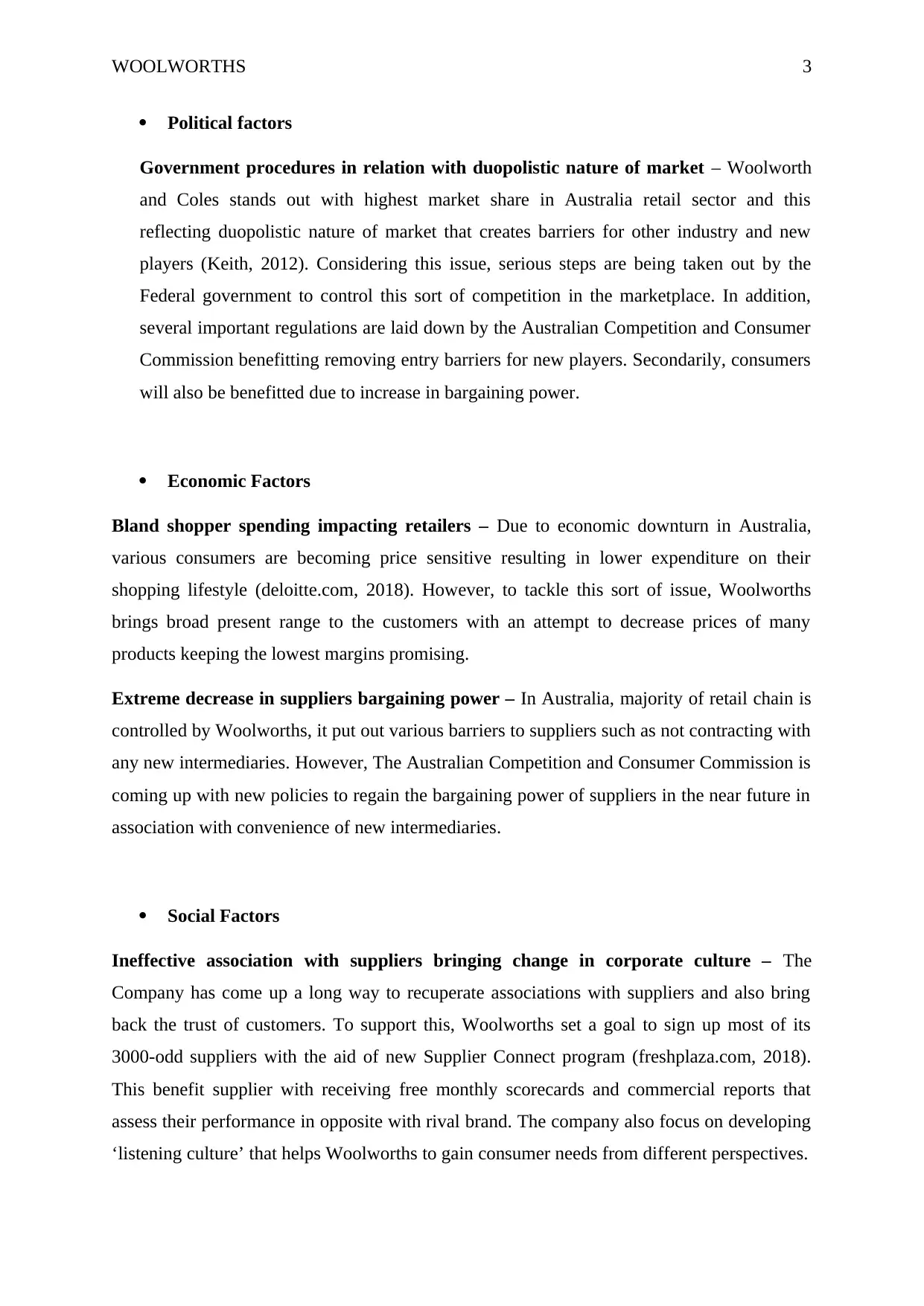
WOOLWORTHS 3
Political factors
Government procedures in relation with duopolistic nature of market – Woolworth
and Coles stands out with highest market share in Australia retail sector and this
reflecting duopolistic nature of market that creates barriers for other industry and new
players (Keith, 2012). Considering this issue, serious steps are being taken out by the
Federal government to control this sort of competition in the marketplace. In addition,
several important regulations are laid down by the Australian Competition and Consumer
Commission benefitting removing entry barriers for new players. Secondarily, consumers
will also be benefitted due to increase in bargaining power.
Economic Factors
Bland shopper spending impacting retailers – Due to economic downturn in Australia,
various consumers are becoming price sensitive resulting in lower expenditure on their
shopping lifestyle (deloitte.com, 2018). However, to tackle this sort of issue, Woolworths
brings broad present range to the customers with an attempt to decrease prices of many
products keeping the lowest margins promising.
Extreme decrease in suppliers bargaining power – In Australia, majority of retail chain is
controlled by Woolworths, it put out various barriers to suppliers such as not contracting with
any new intermediaries. However, The Australian Competition and Consumer Commission is
coming up with new policies to regain the bargaining power of suppliers in the near future in
association with convenience of new intermediaries.
Social Factors
Ineffective association with suppliers bringing change in corporate culture – The
Company has come up a long way to recuperate associations with suppliers and also bring
back the trust of customers. To support this, Woolworths set a goal to sign up most of its
3000-odd suppliers with the aid of new Supplier Connect program (freshplaza.com, 2018).
This benefit supplier with receiving free monthly scorecards and commercial reports that
assess their performance in opposite with rival brand. The company also focus on developing
‘listening culture’ that helps Woolworths to gain consumer needs from different perspectives.
Political factors
Government procedures in relation with duopolistic nature of market – Woolworth
and Coles stands out with highest market share in Australia retail sector and this
reflecting duopolistic nature of market that creates barriers for other industry and new
players (Keith, 2012). Considering this issue, serious steps are being taken out by the
Federal government to control this sort of competition in the marketplace. In addition,
several important regulations are laid down by the Australian Competition and Consumer
Commission benefitting removing entry barriers for new players. Secondarily, consumers
will also be benefitted due to increase in bargaining power.
Economic Factors
Bland shopper spending impacting retailers – Due to economic downturn in Australia,
various consumers are becoming price sensitive resulting in lower expenditure on their
shopping lifestyle (deloitte.com, 2018). However, to tackle this sort of issue, Woolworths
brings broad present range to the customers with an attempt to decrease prices of many
products keeping the lowest margins promising.
Extreme decrease in suppliers bargaining power – In Australia, majority of retail chain is
controlled by Woolworths, it put out various barriers to suppliers such as not contracting with
any new intermediaries. However, The Australian Competition and Consumer Commission is
coming up with new policies to regain the bargaining power of suppliers in the near future in
association with convenience of new intermediaries.
Social Factors
Ineffective association with suppliers bringing change in corporate culture – The
Company has come up a long way to recuperate associations with suppliers and also bring
back the trust of customers. To support this, Woolworths set a goal to sign up most of its
3000-odd suppliers with the aid of new Supplier Connect program (freshplaza.com, 2018).
This benefit supplier with receiving free monthly scorecards and commercial reports that
assess their performance in opposite with rival brand. The company also focus on developing
‘listening culture’ that helps Woolworths to gain consumer needs from different perspectives.
Secure Best Marks with AI Grader
Need help grading? Try our AI Grader for instant feedback on your assignments.
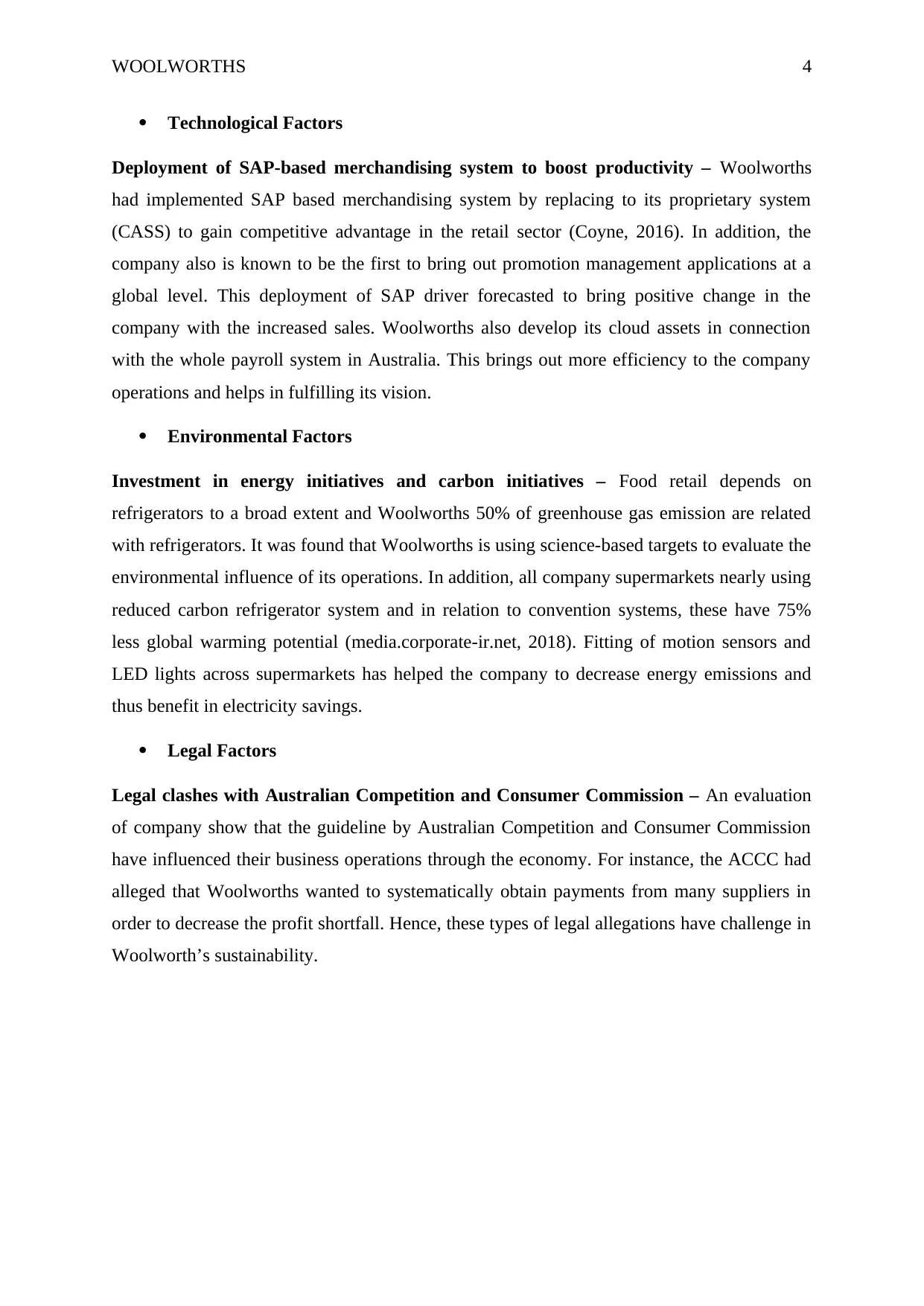
WOOLWORTHS 4
Technological Factors
Deployment of SAP-based merchandising system to boost productivity – Woolworths
had implemented SAP based merchandising system by replacing to its proprietary system
(CASS) to gain competitive advantage in the retail sector (Coyne, 2016). In addition, the
company also is known to be the first to bring out promotion management applications at a
global level. This deployment of SAP driver forecasted to bring positive change in the
company with the increased sales. Woolworths also develop its cloud assets in connection
with the whole payroll system in Australia. This brings out more efficiency to the company
operations and helps in fulfilling its vision.
Environmental Factors
Investment in energy initiatives and carbon initiatives – Food retail depends on
refrigerators to a broad extent and Woolworths 50% of greenhouse gas emission are related
with refrigerators. It was found that Woolworths is using science-based targets to evaluate the
environmental influence of its operations. In addition, all company supermarkets nearly using
reduced carbon refrigerator system and in relation to convention systems, these have 75%
less global warming potential (media.corporate-ir.net, 2018). Fitting of motion sensors and
LED lights across supermarkets has helped the company to decrease energy emissions and
thus benefit in electricity savings.
Legal Factors
Legal clashes with Australian Competition and Consumer Commission – An evaluation
of company show that the guideline by Australian Competition and Consumer Commission
have influenced their business operations through the economy. For instance, the ACCC had
alleged that Woolworths wanted to systematically obtain payments from many suppliers in
order to decrease the profit shortfall. Hence, these types of legal allegations have challenge in
Woolworth’s sustainability.
Technological Factors
Deployment of SAP-based merchandising system to boost productivity – Woolworths
had implemented SAP based merchandising system by replacing to its proprietary system
(CASS) to gain competitive advantage in the retail sector (Coyne, 2016). In addition, the
company also is known to be the first to bring out promotion management applications at a
global level. This deployment of SAP driver forecasted to bring positive change in the
company with the increased sales. Woolworths also develop its cloud assets in connection
with the whole payroll system in Australia. This brings out more efficiency to the company
operations and helps in fulfilling its vision.
Environmental Factors
Investment in energy initiatives and carbon initiatives – Food retail depends on
refrigerators to a broad extent and Woolworths 50% of greenhouse gas emission are related
with refrigerators. It was found that Woolworths is using science-based targets to evaluate the
environmental influence of its operations. In addition, all company supermarkets nearly using
reduced carbon refrigerator system and in relation to convention systems, these have 75%
less global warming potential (media.corporate-ir.net, 2018). Fitting of motion sensors and
LED lights across supermarkets has helped the company to decrease energy emissions and
thus benefit in electricity savings.
Legal Factors
Legal clashes with Australian Competition and Consumer Commission – An evaluation
of company show that the guideline by Australian Competition and Consumer Commission
have influenced their business operations through the economy. For instance, the ACCC had
alleged that Woolworths wanted to systematically obtain payments from many suppliers in
order to decrease the profit shortfall. Hence, these types of legal allegations have challenge in
Woolworth’s sustainability.
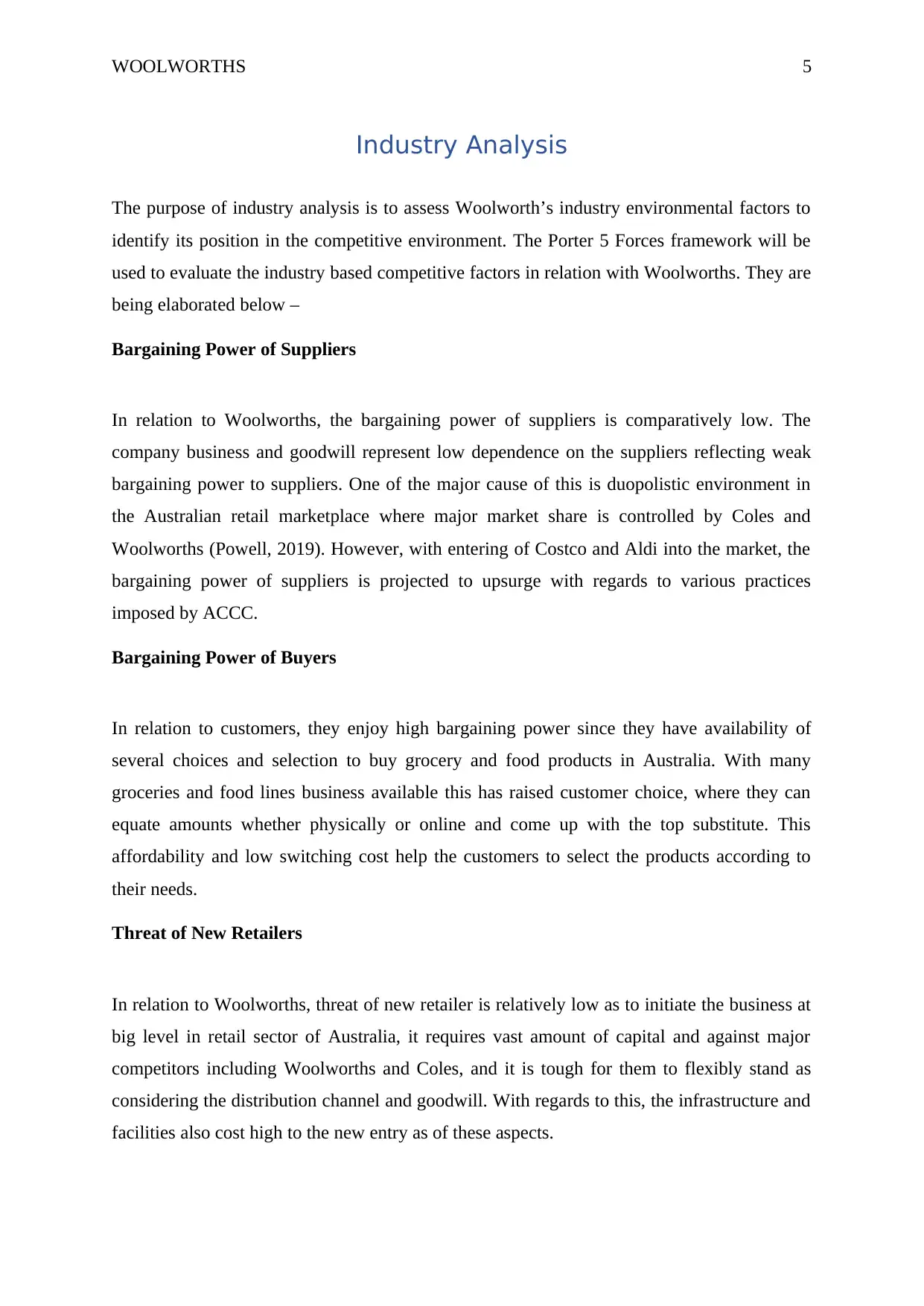
WOOLWORTHS 5
Industry Analysis
The purpose of industry analysis is to assess Woolworth’s industry environmental factors to
identify its position in the competitive environment. The Porter 5 Forces framework will be
used to evaluate the industry based competitive factors in relation with Woolworths. They are
being elaborated below –
Bargaining Power of Suppliers
In relation to Woolworths, the bargaining power of suppliers is comparatively low. The
company business and goodwill represent low dependence on the suppliers reflecting weak
bargaining power to suppliers. One of the major cause of this is duopolistic environment in
the Australian retail marketplace where major market share is controlled by Coles and
Woolworths (Powell, 2019). However, with entering of Costco and Aldi into the market, the
bargaining power of suppliers is projected to upsurge with regards to various practices
imposed by ACCC.
Bargaining Power of Buyers
In relation to customers, they enjoy high bargaining power since they have availability of
several choices and selection to buy grocery and food products in Australia. With many
groceries and food lines business available this has raised customer choice, where they can
equate amounts whether physically or online and come up with the top substitute. This
affordability and low switching cost help the customers to select the products according to
their needs.
Threat of New Retailers
In relation to Woolworths, threat of new retailer is relatively low as to initiate the business at
big level in retail sector of Australia, it requires vast amount of capital and against major
competitors including Woolworths and Coles, and it is tough for them to flexibly stand as
considering the distribution channel and goodwill. With regards to this, the infrastructure and
facilities also cost high to the new entry as of these aspects.
Industry Analysis
The purpose of industry analysis is to assess Woolworth’s industry environmental factors to
identify its position in the competitive environment. The Porter 5 Forces framework will be
used to evaluate the industry based competitive factors in relation with Woolworths. They are
being elaborated below –
Bargaining Power of Suppliers
In relation to Woolworths, the bargaining power of suppliers is comparatively low. The
company business and goodwill represent low dependence on the suppliers reflecting weak
bargaining power to suppliers. One of the major cause of this is duopolistic environment in
the Australian retail marketplace where major market share is controlled by Coles and
Woolworths (Powell, 2019). However, with entering of Costco and Aldi into the market, the
bargaining power of suppliers is projected to upsurge with regards to various practices
imposed by ACCC.
Bargaining Power of Buyers
In relation to customers, they enjoy high bargaining power since they have availability of
several choices and selection to buy grocery and food products in Australia. With many
groceries and food lines business available this has raised customer choice, where they can
equate amounts whether physically or online and come up with the top substitute. This
affordability and low switching cost help the customers to select the products according to
their needs.
Threat of New Retailers
In relation to Woolworths, threat of new retailer is relatively low as to initiate the business at
big level in retail sector of Australia, it requires vast amount of capital and against major
competitors including Woolworths and Coles, and it is tough for them to flexibly stand as
considering the distribution channel and goodwill. With regards to this, the infrastructure and
facilities also cost high to the new entry as of these aspects.
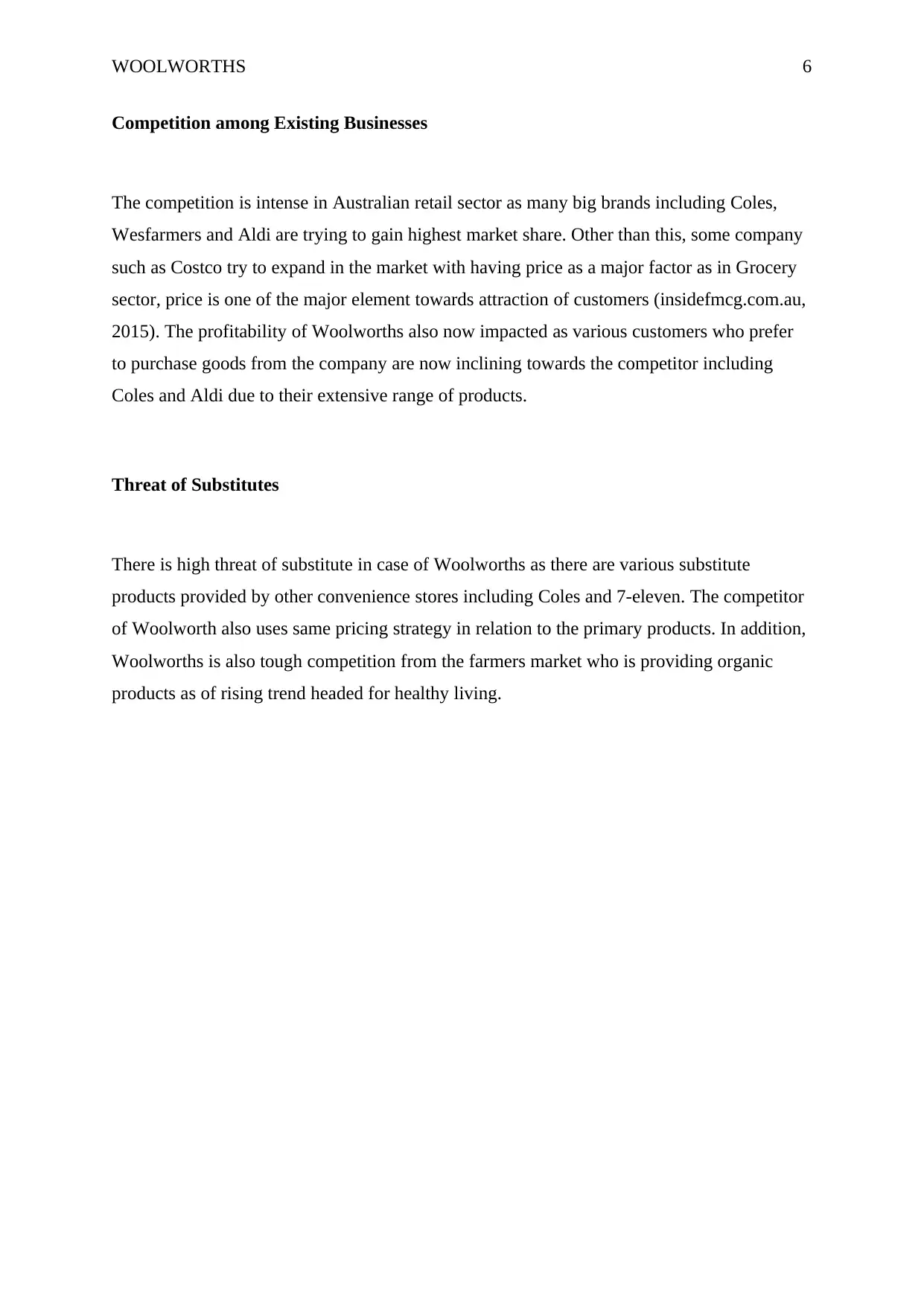
WOOLWORTHS 6
Competition among Existing Businesses
The competition is intense in Australian retail sector as many big brands including Coles,
Wesfarmers and Aldi are trying to gain highest market share. Other than this, some company
such as Costco try to expand in the market with having price as a major factor as in Grocery
sector, price is one of the major element towards attraction of customers (insidefmcg.com.au,
2015). The profitability of Woolworths also now impacted as various customers who prefer
to purchase goods from the company are now inclining towards the competitor including
Coles and Aldi due to their extensive range of products.
Threat of Substitutes
There is high threat of substitute in case of Woolworths as there are various substitute
products provided by other convenience stores including Coles and 7-eleven. The competitor
of Woolworth also uses same pricing strategy in relation to the primary products. In addition,
Woolworths is also tough competition from the farmers market who is providing organic
products as of rising trend headed for healthy living.
Competition among Existing Businesses
The competition is intense in Australian retail sector as many big brands including Coles,
Wesfarmers and Aldi are trying to gain highest market share. Other than this, some company
such as Costco try to expand in the market with having price as a major factor as in Grocery
sector, price is one of the major element towards attraction of customers (insidefmcg.com.au,
2015). The profitability of Woolworths also now impacted as various customers who prefer
to purchase goods from the company are now inclining towards the competitor including
Coles and Aldi due to their extensive range of products.
Threat of Substitutes
There is high threat of substitute in case of Woolworths as there are various substitute
products provided by other convenience stores including Coles and 7-eleven. The competitor
of Woolworth also uses same pricing strategy in relation to the primary products. In addition,
Woolworths is also tough competition from the farmers market who is providing organic
products as of rising trend headed for healthy living.
Paraphrase This Document
Need a fresh take? Get an instant paraphrase of this document with our AI Paraphraser
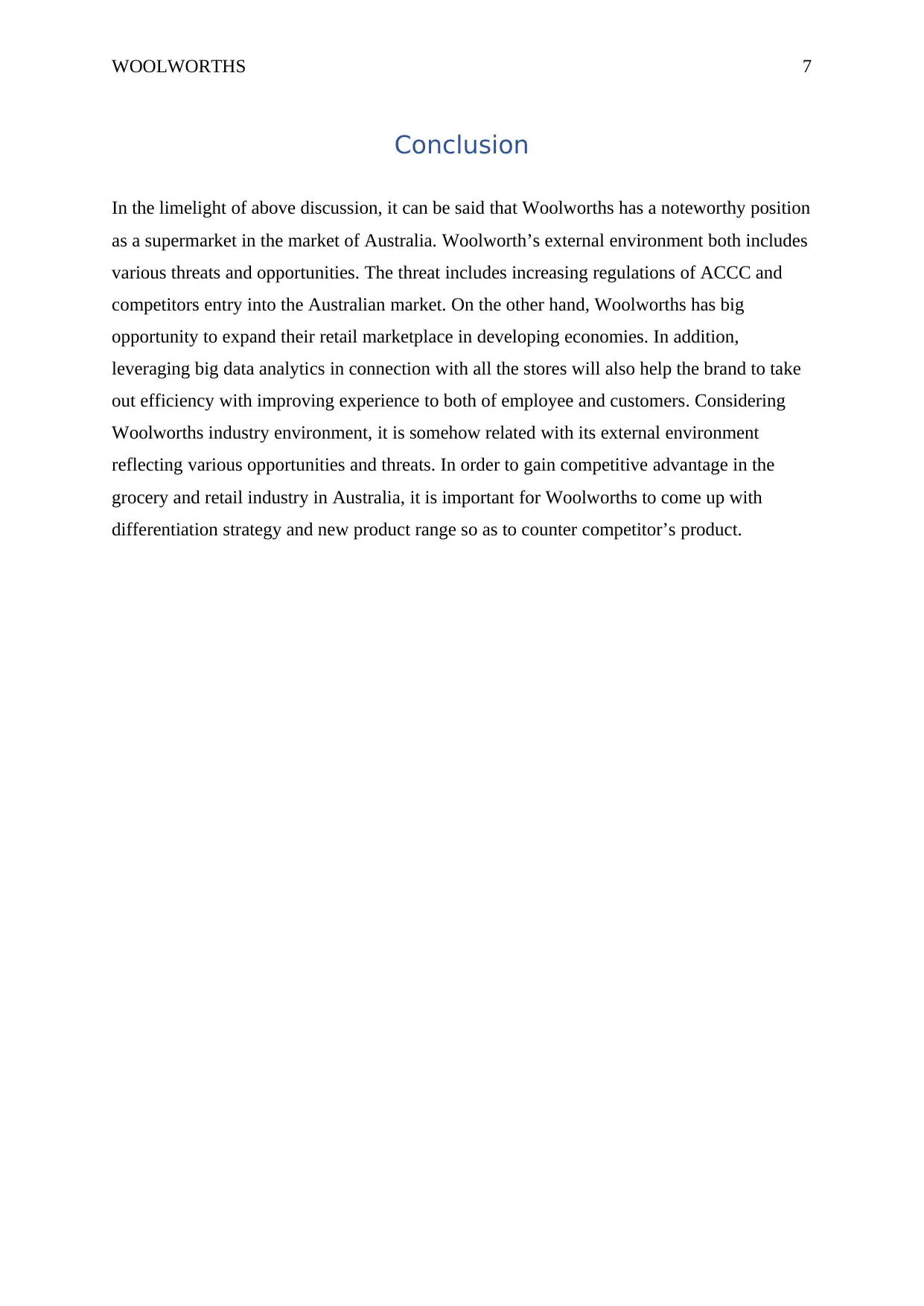
WOOLWORTHS 7
Conclusion
In the limelight of above discussion, it can be said that Woolworths has a noteworthy position
as a supermarket in the market of Australia. Woolworth’s external environment both includes
various threats and opportunities. The threat includes increasing regulations of ACCC and
competitors entry into the Australian market. On the other hand, Woolworths has big
opportunity to expand their retail marketplace in developing economies. In addition,
leveraging big data analytics in connection with all the stores will also help the brand to take
out efficiency with improving experience to both of employee and customers. Considering
Woolworths industry environment, it is somehow related with its external environment
reflecting various opportunities and threats. In order to gain competitive advantage in the
grocery and retail industry in Australia, it is important for Woolworths to come up with
differentiation strategy and new product range so as to counter competitor’s product.
Conclusion
In the limelight of above discussion, it can be said that Woolworths has a noteworthy position
as a supermarket in the market of Australia. Woolworth’s external environment both includes
various threats and opportunities. The threat includes increasing regulations of ACCC and
competitors entry into the Australian market. On the other hand, Woolworths has big
opportunity to expand their retail marketplace in developing economies. In addition,
leveraging big data analytics in connection with all the stores will also help the brand to take
out efficiency with improving experience to both of employee and customers. Considering
Woolworths industry environment, it is somehow related with its external environment
reflecting various opportunities and threats. In order to gain competitive advantage in the
grocery and retail industry in Australia, it is important for Woolworths to come up with
differentiation strategy and new product range so as to counter competitor’s product.
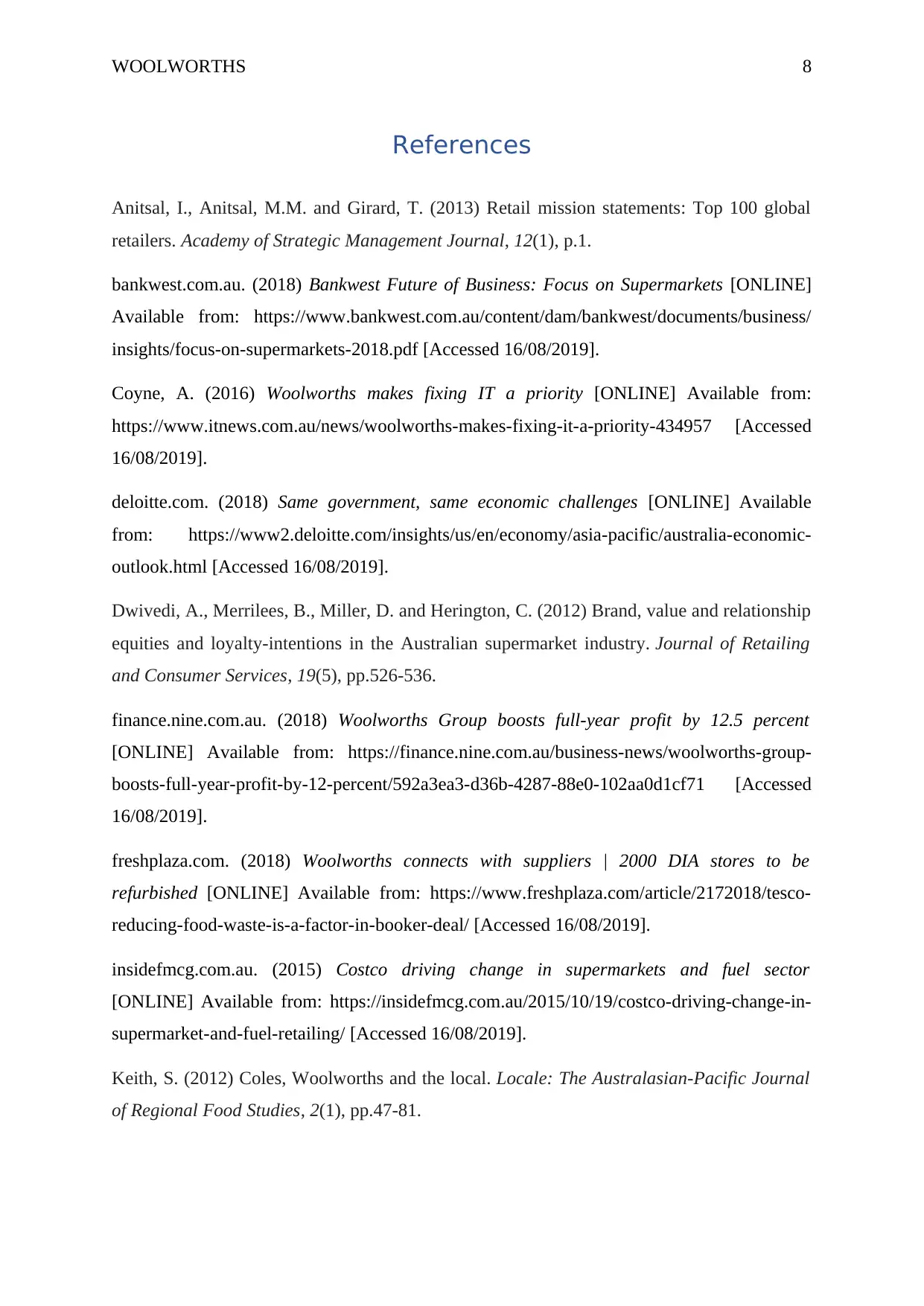
WOOLWORTHS 8
References
Anitsal, I., Anitsal, M.M. and Girard, T. (2013) Retail mission statements: Top 100 global
retailers. Academy of Strategic Management Journal, 12(1), p.1.
bankwest.com.au. (2018) Bankwest Future of Business: Focus on Supermarkets [ONLINE]
Available from: https://www.bankwest.com.au/content/dam/bankwest/documents/business/
insights/focus-on-supermarkets-2018.pdf [Accessed 16/08/2019].
Coyne, A. (2016) Woolworths makes fixing IT a priority [ONLINE] Available from:
https://www.itnews.com.au/news/woolworths-makes-fixing-it-a-priority-434957 [Accessed
16/08/2019].
deloitte.com. (2018) Same government, same economic challenges [ONLINE] Available
from: https://www2.deloitte.com/insights/us/en/economy/asia-pacific/australia-economic-
outlook.html [Accessed 16/08/2019].
Dwivedi, A., Merrilees, B., Miller, D. and Herington, C. (2012) Brand, value and relationship
equities and loyalty-intentions in the Australian supermarket industry. Journal of Retailing
and Consumer Services, 19(5), pp.526-536.
finance.nine.com.au. (2018) Woolworths Group boosts full-year profit by 12.5 percent
[ONLINE] Available from: https://finance.nine.com.au/business-news/woolworths-group-
boosts-full-year-profit-by-12-percent/592a3ea3-d36b-4287-88e0-102aa0d1cf71 [Accessed
16/08/2019].
freshplaza.com. (2018) Woolworths connects with suppliers | 2000 DIA stores to be
refurbished [ONLINE] Available from: https://www.freshplaza.com/article/2172018/tesco-
reducing-food-waste-is-a-factor-in-booker-deal/ [Accessed 16/08/2019].
insidefmcg.com.au. (2015) Costco driving change in supermarkets and fuel sector
[ONLINE] Available from: https://insidefmcg.com.au/2015/10/19/costco-driving-change-in-
supermarket-and-fuel-retailing/ [Accessed 16/08/2019].
Keith, S. (2012) Coles, Woolworths and the local. Locale: The Australasian-Pacific Journal
of Regional Food Studies, 2(1), pp.47-81.
References
Anitsal, I., Anitsal, M.M. and Girard, T. (2013) Retail mission statements: Top 100 global
retailers. Academy of Strategic Management Journal, 12(1), p.1.
bankwest.com.au. (2018) Bankwest Future of Business: Focus on Supermarkets [ONLINE]
Available from: https://www.bankwest.com.au/content/dam/bankwest/documents/business/
insights/focus-on-supermarkets-2018.pdf [Accessed 16/08/2019].
Coyne, A. (2016) Woolworths makes fixing IT a priority [ONLINE] Available from:
https://www.itnews.com.au/news/woolworths-makes-fixing-it-a-priority-434957 [Accessed
16/08/2019].
deloitte.com. (2018) Same government, same economic challenges [ONLINE] Available
from: https://www2.deloitte.com/insights/us/en/economy/asia-pacific/australia-economic-
outlook.html [Accessed 16/08/2019].
Dwivedi, A., Merrilees, B., Miller, D. and Herington, C. (2012) Brand, value and relationship
equities and loyalty-intentions in the Australian supermarket industry. Journal of Retailing
and Consumer Services, 19(5), pp.526-536.
finance.nine.com.au. (2018) Woolworths Group boosts full-year profit by 12.5 percent
[ONLINE] Available from: https://finance.nine.com.au/business-news/woolworths-group-
boosts-full-year-profit-by-12-percent/592a3ea3-d36b-4287-88e0-102aa0d1cf71 [Accessed
16/08/2019].
freshplaza.com. (2018) Woolworths connects with suppliers | 2000 DIA stores to be
refurbished [ONLINE] Available from: https://www.freshplaza.com/article/2172018/tesco-
reducing-food-waste-is-a-factor-in-booker-deal/ [Accessed 16/08/2019].
insidefmcg.com.au. (2015) Costco driving change in supermarkets and fuel sector
[ONLINE] Available from: https://insidefmcg.com.au/2015/10/19/costco-driving-change-in-
supermarket-and-fuel-retailing/ [Accessed 16/08/2019].
Keith, S. (2012) Coles, Woolworths and the local. Locale: The Australasian-Pacific Journal
of Regional Food Studies, 2(1), pp.47-81.
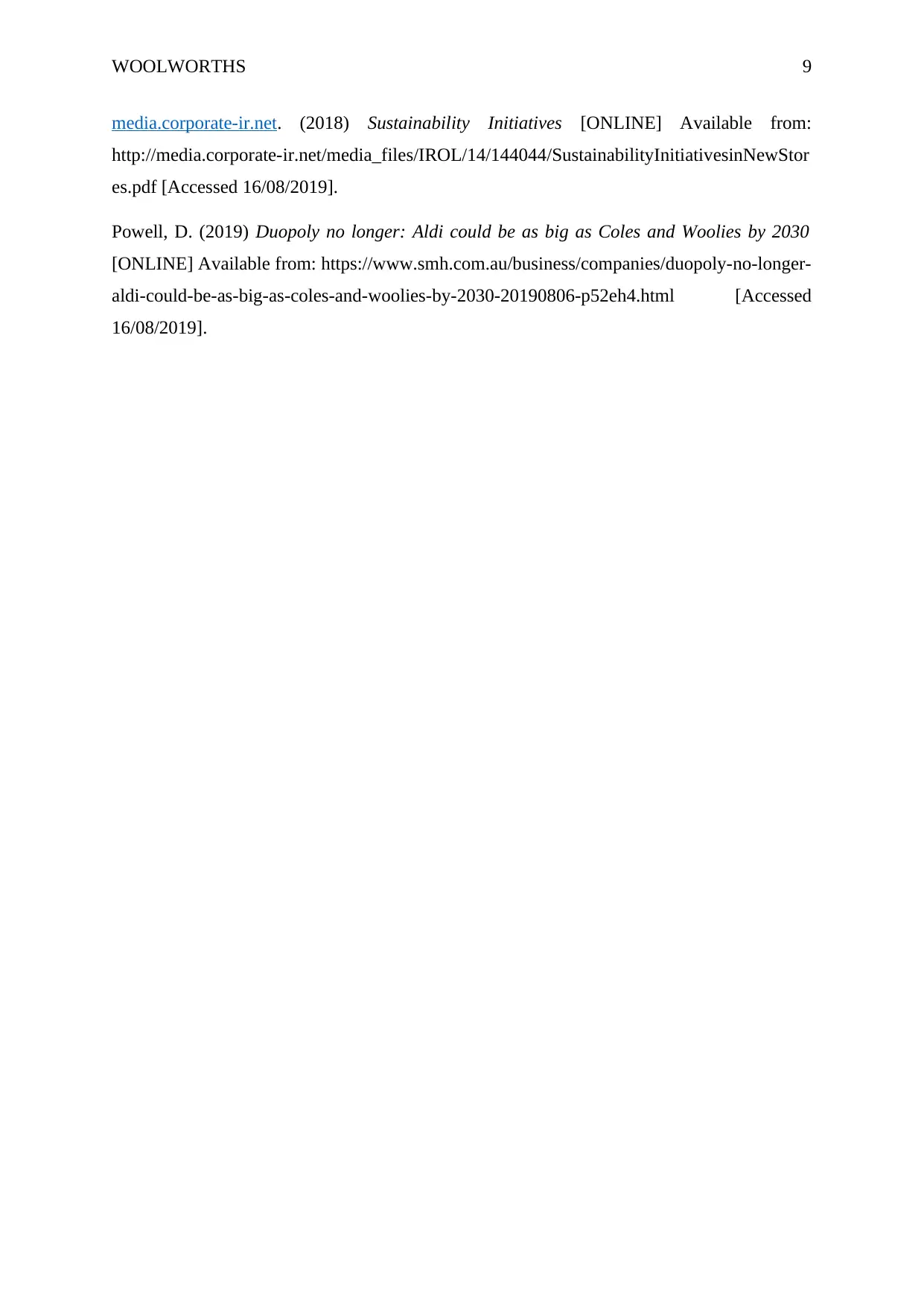
WOOLWORTHS 9
media.corporate-ir.net. (2018) Sustainability Initiatives [ONLINE] Available from:
http://media.corporate-ir.net/media_files/IROL/14/144044/SustainabilityInitiativesinNewStor
es.pdf [Accessed 16/08/2019].
Powell, D. (2019) Duopoly no longer: Aldi could be as big as Coles and Woolies by 2030
[ONLINE] Available from: https://www.smh.com.au/business/companies/duopoly-no-longer-
aldi-could-be-as-big-as-coles-and-woolies-by-2030-20190806-p52eh4.html [Accessed
16/08/2019].
media.corporate-ir.net. (2018) Sustainability Initiatives [ONLINE] Available from:
http://media.corporate-ir.net/media_files/IROL/14/144044/SustainabilityInitiativesinNewStor
es.pdf [Accessed 16/08/2019].
Powell, D. (2019) Duopoly no longer: Aldi could be as big as Coles and Woolies by 2030
[ONLINE] Available from: https://www.smh.com.au/business/companies/duopoly-no-longer-
aldi-could-be-as-big-as-coles-and-woolies-by-2030-20190806-p52eh4.html [Accessed
16/08/2019].
1 out of 10
Related Documents
Your All-in-One AI-Powered Toolkit for Academic Success.
+13062052269
info@desklib.com
Available 24*7 on WhatsApp / Email
![[object Object]](/_next/static/media/star-bottom.7253800d.svg)
Unlock your academic potential
© 2024 | Zucol Services PVT LTD | All rights reserved.




